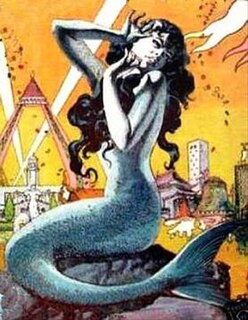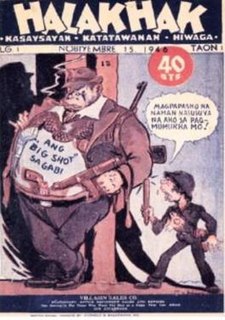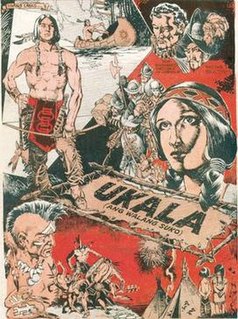Related Research Articles
Valentina is a supervillain created by Mars Ravelo and Nestor Redondo who first appeared in the second episode of the Darna series published in the Philippine comics Pilipino Komiks. One of the most recognizable supervillainess characters in the Philippines, she is the archenemy of Darna. She was originally a bitter, deformed woman born from ordinary human parents with venomous snakes on her head that appears to be like hair. When she grew up, she killed her parents and was subsequently taken in by a serpent creature named Kobra. Valentina was soon referred to as "goddess of the snakes".
Liwayway is a leading Tagalog weekly magazine published in the Philippines since 1922. It contains Tagalog serialized novels, short stories, poetry, serialized comics, essays, news features, entertainment news and articles, and many others. In fact, it is the oldest Tagalog magazine in the Philippines. Its sister publications are Bannawag, Bisaya Magasin, and Hiligaynon.

Zsazsa Zaturnnah is a fictional comic book superheroine created by Filipino illustrator and graphic designer Carlo Vergara. The character first appeared in the Filipino graphic novel, Ang Kagila-gilalas na Pakikipagsapalaran ni Zsazsa Zaturnnah, originally a self-published work in December 2002 consisting of two parts. It was later distributed and merged in a single volume by Visprint Inc.. The graphic novel won a National Book Award in 2003 given by the Manila Critics Circle. It was the 12th bestselling fiction book among Philippine publications in 2005 based on the records of National Book Store.
Lauro "Larry" Zarate Alcala was a well-known editorial cartoonist and illustrator in the Philippines. In 2018, he was posthumously conferred the National Artist for Visual Arts title and the Grand Collar of the Order of National Artists.
Comics in the Philippines have been widespread and popular throughout the country from the 1920s to the present. Komiks were partially inspired by American mainstream comic strips and comic books during the early 20th century. The medium first became widely popular after World War II. Its mainstream appeal subsided somewhat during the latter part of the 20th century with the advent of other mass-media forms such as telenovelas, but experienced a renaissance in the mid-2010s with the increasing popularity of artists such as Gerry Alanguilan, Arnold Arre, Budjette Tan, Kajo Baldisimo, and the rise of fan communities through comic book conventions such as komikon. Webcomics produced by independent Filipino web-based artists have caught the attention of local and foreign readers.
Zuma is a Filipino comic book character created by Jim Fernandez in 1974. The character first appeared in a serial written by Fernandez entitled Aztec. From 1976 to 1985, Zuma got his own series named Anak ni Zuma that was serialized in Aliwan Komiks published by Graphics Arts Service Inc. with illustration by Ben Maniclang. The comics series was the biggest best seller for Aliwan. Following this publication success, spin-offs and a 1990s reboot about the character were published and it was further expanded in other media including film and television.

Dyesebel is a Filipino comic book character, conceived by Mars Ravelo and drawn by Elpidio Torres. Dyesebel is a mermaid, who eventually gains full human form through a deal with a sea-witch.
Jim M. Fernandez is a Filipino comic book artist best known for his works on Aztec and Aliwan Komiks. He also popularized the fictional character, Zuma in his novels. Apart from being an editor, illustrator, cartoonist, and writer for Philippine comics, Fernandez was also a certified public accountant in the Philippines.
Filipino cartoon and animation, also known as Pinoy cartoon and animation, is a body of original cultural and artistic works and styles applied to conventional Filipino storytelling, combined with talent and the appropriate application of classic animation principles, methods, and techniques, which recognizes their relationship with Filipino culture, comics, and films. It also delves into relying on traditional and common Filipino "sense of going about things" or manner of coping with Filipino life and environment.

Combatron is a Filipino superhero. Created by Berlin H. Manalaysay, he first appeared in Funny Komiks in 1992.
Lagim is one of the first Filipino superhero characters in the Philippines. He was created by Filipino artist Cris CaGuintuan. Lagim's first appearance was in the pages of Pilipino Komiks #60 in 1947 or 1949. His sidekick was a boy named Levy, a young lad he saved in the past, and wore a costume similar to the uniform worn by Robin, the sidekick of the American superhero Batman.
José Zabala-Santos, nicknamed as "Mang Pepe" by hometown neighbors and as "Zabala" by colleagues in the cartooning profession, was a successful cartoonist in the Philippines and was one of the pioneers of Philippine comics. He became one of the most popular cartoonists in the Philippines during the 1950s because of his cartoon characters such Popoy, Sianong Sano, and Lukas Malakas. Zabala is one of the "respected names" of artists in the Philippine cartoon and comics industry.

Halakhak Komiks is the first regularly published comics magazine in the Philippines. Its first publication was on November 15, 1946. It was founded by Filipino illustrator Isaac Tolentino and Filipino lawyer Jaime Lucas.
Antonio "Tony" Velasquez is a Filipino illustrator regarded as the Father of Tagalog comics and as the pioneer and founding father of the Philippine comics industry. He was the creator of Kenkoy, an “iconic Philippine comic strip character”.

Francisco "Kenkoy" Harabas is a Philippine comics character created by writer Romualdo Ramos and cartoonist and illustrator Tony Velasquez in 1929. Velazquez continued the strip for decades after Ramos' death in 1932. Kenkoy was seminal to Philippine comics and thus Velasquez is considered the founding father of the industry. The term kenkoy has entered the Filipino language to mean a joker, jester, or a hilarious person.
Died: February 21, 2021

Ukala , meaning "Ukala " [i.e. the one who doesn't give up] was a comic strip title in Philippine comics. The main character in the comic book story is Ukala. Ukala was created in the 1950s by distinguished Filipino illustrator Alfredo Alcala. Ukala, the character, was a Native American Indian or "Amerindian". The story, written and illustrated by Alcala for Filipino readers, was about the adventures of Native American Indians set at a timeline when the first Europeans arrived in the Northwestern region of the Americas. Ukala was adapted into film as Ukala , meaning "Ukala " in the Tagalog language. It appeared on the pages of the Philippine comic book named Pilipino Komiks.
Virgilio "Virgil" Redondo y Purugganan was a Filipino comic book writer and artist.
References
- 1 2 3 4 "Private Site".